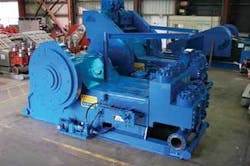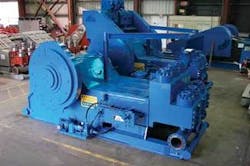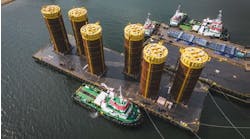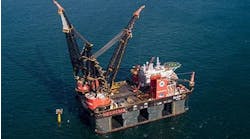Richard Urquhart, National Oilwell Varco
Like many oil and gas industry technologies, changes in the means of converting fuel into hoisting, lowering, rotating, and pumping power with drilling equipment have been driven by the need for increased performance. The latest technology to enter the scene is permanent magnet (PM) motors.
The introduction of permanent magnets
There have been various major transitions of technology, from steam engines and compound drives, to mechanical driven engines with torque converters. In the late 1970s, the industry transitioned to DC (direct current) motor technology as drilling rigs turned to electric motors. The subsequent progressions involved advances made in the early 1990s with the advent of large horsepower AC (alternating current) drilling motor technology.
The permanent magnet motor differs from the industry standard AC asynchronous motor in that it uses magnets to generate the power that turns the motor instead of using excitation, or energizing large copper wound stators, to turn the motor. The PM AC motor performs better than an AC motor in a number of ways. A primary benefit is increased power. A permanent magnet motor can produce as much as three times the power density of a conventional, similarly sized AC motor. Additional power provides the opportunity to almost triple the performance in the same package size. Alternatively, the size and weight of the motor could be reduced by nearly two-thirds and still maintain the original performance.
National Oilwell Varco (NOV) is beginning to show promising results applying permanent magnet motors and technology across its drilling product lines. Systems have been introduced with man riding winches, cranes, and topdrives, while developments are progressing with drawworks and mud pumps. There is clearly a move toward this technology, which begs the question, “Why?”
Permanent magnet motor advantages
One of the clear advantages of PM motor technology is that the motor can be very small and compact compared to an asynchronous induction motor (AC motor). Size and weight always have been a challenge to increasing performance of prime movers.
National Oilwell Varco’s 12P pump features a permanent magnet motor.
Using PM motors in lifting applications has unique advantages. The PM design has “integrated” braking capability in case of power failure. Complete power loss on the rig triggers the PM motor to create its own magnetic field and to work as a generator if exposed to external loads. This is achieved by short-circuiting the windings in the PM motor, directly or via resistors. Winches usually are equipped with a fail-safe mechanical brake that is applied automatically in case of a power failure.
Emergency lowering is managed by releasing the mechanical brake. Resistors and fail-safe switches can be installed in connection with the control cabinet, and when the electro-mechanical emergency brake on the winch is released, a controlled emergency lowering can be performed. This feature for the PM motor also can be used as an extra dynamic emergency brake.
Industry application
One of the first PM motors introduced to the offshore industry was a small PM motor used in a man rider winch. The winch uses a small inside-out PM motor, meaning that the outer housing of the motor is the rotating part, while the shaft is stationary, in contrast to standard motors where the shaft is the rotating part. The motor is placed inside the winch drum with the cables coming into the motor through the shaft. This makes the design of the winch small and compact compared with standard electrical winches.
A prototype drawworks using the same inside-out motor technology provides a breakthrough in what has been a packaging challenge for deepwater and deep well applications on larger rigs. NOV’s 3,200-hp drawworks has a footprint that is 45% smaller and weighs 40% less than a traditional AC-driven drawworks. The design is being tested and likely will be introduced to the market in 2008.
PM technology also has been used within rig cranes, producing an all electrical king post crane.
A look at the industry indicated a need for high power topdrive technology to be moved to small masts on land rigs. As a result, NOV developed the IDS 350, which uses a 700 hp PM motor to meet this need. The topdrive design incorporates a PM motor into the original design with a through motor mud course, a design initially introduced in the early ’80s. The small diameter PM motor can be fitted to the machine to create a high-capacity topdrive that is very small, facilitating the use of topdrives with 350-ton (317.5-metric-ton) hoisting capacity where they were unable to fit before. The technology is still in the early field trials, but as the prototypes move to production, this application is deemed to be a game changer for smaller land rig drilling applications.
Development also is under way on a patented new form of AC motor known as the “direct drive” permanent magnet (DDPM) motor.
An initial development project is the 800 hp DDPM AC motor specifically designed for NOV mud pumps. DDPM technology provides sufficient torque and speed to power or drive a conventional triplex mud pump directly at the pump’s pinion shaft. This means there is no need for traditional belt or chain drive components. The DDPM AC motors reduce the pump weight an average of 20%. This is a significant weight saving considering that some of the newbuild rigs have as many as five pumps. The footprint of the pump package also could be reduced by over 20%, which helps on offshore rigs where space is expensive.
Removing the traditional drive system also reduces the total number of moving parts, which can drastically reduce maintenance requirements. Removing both the motors and the drive system also reduces noise emissions.
The era of permanent magnet motors seems to have begun. The machines of tomorrow are being designed and developed to take advantage of this technology.




